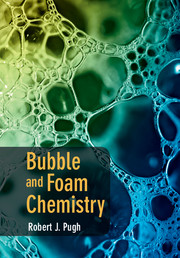Book contents
- Frontmatter
- Contents
- Preface
- Acknowledgments
- List of symbols
- 1 Basic principles and concepts
- 2 The nature and properties of foaming surfactants
- 3 Soap bubbles and thin films
- 4 Processes in foaming
- 5 Generation of bubbles and foams
- 6 Coalescence of bubbles in surfactant solutions
- 7 The stability/instability of bubbles and foams
- 8 Particle-stabilized foams
- 9 Foaming in non-aqueous liquids
- 10 Antifoaming and defoaming
- 11 Bubble size measurements and foam test methods
- 12 Bubble and foam chemistry - new areas of foam research
- Index
- References
5 - Generation of bubbles and foams
Published online by Cambridge University Press: 05 September 2016
- Frontmatter
- Contents
- Preface
- Acknowledgments
- List of symbols
- 1 Basic principles and concepts
- 2 The nature and properties of foaming surfactants
- 3 Soap bubbles and thin films
- 4 Processes in foaming
- 5 Generation of bubbles and foams
- 6 Coalescence of bubbles in surfactant solutions
- 7 The stability/instability of bubbles and foams
- 8 Particle-stabilized foams
- 9 Foaming in non-aqueous liquids
- 10 Antifoaming and defoaming
- 11 Bubble size measurements and foam test methods
- 12 Bubble and foam chemistry - new areas of foam research
- Index
- References
Summary
You don't start to play your guitar thinking you're going to be running an organization that will maybe generate millions.
Keith Richards, www.quoteauthors.com/keith-richards-quotes/Introduction
There are a number of methods for generating foams, and these have been reasonably well documented throughout the literature. They may be classified into two groups; the first involves the entrapment of air bubbles from the atmosphere and this can be achieved by relatively simple techniques such as shaking, pouring, circulation, sparging (introduction of gas using frits), etc. The second method involves artificially producing gas bubbles by physical methods (e.g. by nucleation or electrolysis) or chemical methods, which are commonly exploited in the production of polymer foams and involve the use of so-called blowing agents. These are chemical compounds that decompose or react to produce gas bubbles. While it is difficult to control the bubble size using physical methods of bubble formation, with chemical methods it is much easier to achieve a narrow-size distribution along with a high generation rate. Many different types of gases are used for foam generation, but it is important to recognize that foams generated with less soluble gases, such as N2 or air, will coarsen more slowly than foams produced with more soluble gases such as CO2 since gas diffusion through the soap films is largely determined by the gas solubility and the diffusion coefficient. In traditional foaming processes such as froth flotation, mechanical air entrapment methods are frequently used since they are relatively inexpensive, whereas in the production of material foams more sophisticated chemical processes have been developed.
The adsorption of surfactant on the freshly generated bubbles
The initial step in the generation of bubbles and foams involves the formation of a gas/liquid interface. This process involves work which can be quantified as the product of the interfacial tension and the increase in area of the interface; it be expressed by the equation
where ΔA is the created interfacial area and γ is the surface tension of the freshly produced bubbles. In water, bubbles have a high interfacial energy and become instantly unstable. Therefore, it is essential that surfactant adsorbs at the interface and reduces the surface tension and stabilizes the bubble. The adsorption kinetics plays an important role in the stabilization of the bubble, and the surfactant molecules need to rapidly diffuse from the bulk solution to the bubble interface.
- Type
- Chapter
- Information
- Bubble and Foam Chemistry , pp. 155 - 193Publisher: Cambridge University PressPrint publication year: 2016
References
- 3
- Cited by



